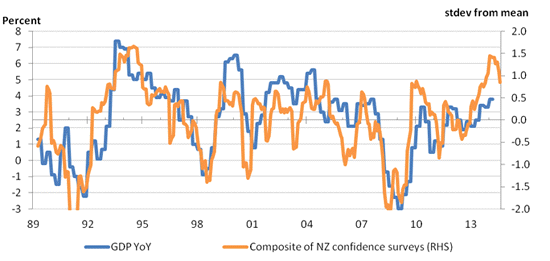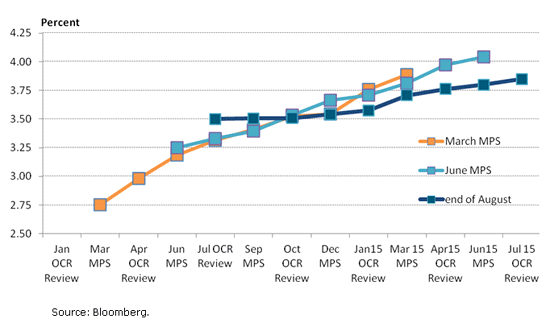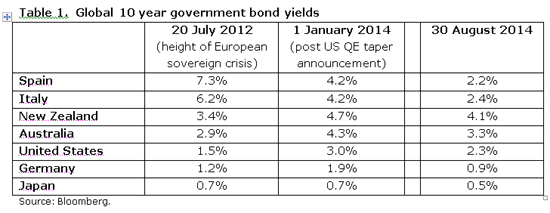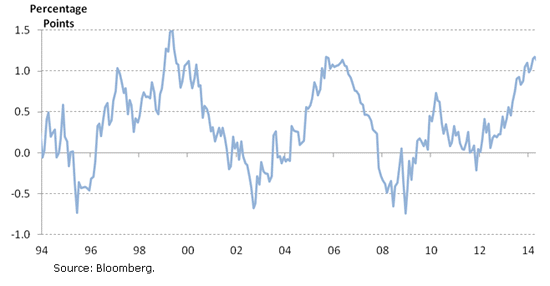
This article is Harbour Asset Management's latest fixed interest market commentary.
By Christian Hawkesby*
• NZ 2 year swap rate was little changed over August, trading in a narrow 4.00 to 4.10% range.
• NZ economic data since the RBNZ’s June Monetary Policy Statement has been mixed, with dairy prices sharply lower and net migration reaching new record highs. Other data has moderated, as expected with higher interest rates.
• At the upcoming September Monetary Policy Statement we expect the RBNZ to reiterate the message that it is prudent to pause for a while and further assess developments.
• The Overnight Indexed Swap (OIS) market is already pricing in a delay until April 2015 before the next full 25 basis point increase in the Official Cash Rate (OCR).
• While NZ short term interest rates were stable, long-term bond yields fell around 20 basis points in August. This has been driven by global bond markets that are focused on European economic weakness and the chance of action from the ECB to keep European interest rates lower for longer.
• As the US economy continues its post GFC repair, we expect long-term yields to rise as the market refocuses on the need for the US Federal Reserve to set out a roadmap for removing policy stimulus.
RBNZ still in a period of prudent assessment
At the end of July, the RBNZ met market expectations by lifting the Official Cash Rate (OCR) to 3.50%, but surprised many in the market with the explicit statement that “it is prudent that there is now a period of assessment before interest rates adjust further”.
The September Monetary Policy Statement will provide the first chance for the RBNZ to update its economic forecasts, and provide a steer on how long they expect to be on hold before resuming the tightening cycle. Since their last forecasts, we judge that the key drivers of their forecasts have fallen into the following categories:
Weaker than expected
- Dairy prices have been the main downside surprise. While the GDT dairy auctions have stabilised in recent weeks, prices are still 35% lower than the start of the year, and 20% lower than the June Monetary Policy Statement.
- The Q2 CPI inflation release was lower than expected at 1.5%, leaving inflation comfortably below the mid point 2% target. Furthermore, there is little sign of building wage inflation in the labour market.
Broadly as expected
- Business and consumer confidence measures have continued to moderate, largely as expected. By our measure, these confidence indicators have gone from flagging 6.5% GDP growth (which always felt too strong) to indicating something below 5%, which is closer to the current reading of 3.8%.
- House prices and sales activity has continued to moderate, as expected with interest rates rising. National house price inflation is solid at around 7% yoy.
- The NZ dollar has fallen around a 1 cent to 0.8365, leaving the Trade Weighted Index (TWI) broadly in line with the RBNZ’s forecasts.
- NZ Q1 GDP growth was roughly in line with market expectations.
- Trading partner growth has been broadly stable, with some stronger data from the US and Australia offset by softer economic data and geopolitical concerns in Europe. China has not slowed as much as some commentators feared.
Chart 1. Consumer and business confidence surveys and NZ GDP growth

Source: Bloomberg and Harbour calculations.
Notes: The Composite of NZ confidence surveys includes 2 business confidence survey measures – ANZ own business conditions and NZIER business confidence – and 2 consumer confidence surveys – Westpac and ANZ/Roy Morgan consumer confidence. These measures are normalised by their averages and standard deviations, and combined into a composite equally weighted average measure. NZ GDP growth has averaged 2.5% over the time period.
Stronger than expected
- Net migration contributed the main upside surprise, reaching new record levels, matching the RBNZ’s own ‘upside scenario’ in its last set of forecasts.
- Unemployment fell further than expected to 5.6%, flagging potential future wage inflation in the pipeline.
- Fixed mortgage rates have fallen since the June Monetary Policy Statement, in part driven by strong competition between banks to win market share. In effect this softens the overall impact of recent OCR increases.
Reflecting this mixed bag of economic data, NZ 2 year swap rate was little changed over August, trading in a narrow 4.00 to 4.10% range.
On balance, we expect the tone of the September Monetary Policy Statement to be similar to the July OCR Review, which came closely on the heels of the two main downside surprises for the economy – falling dairy prices and CPI inflation below expectations. Having only flagged in July that “it is prudent that there is now a period of assessment before interest rates adjust further”, we do not expect the RBNZ to provide a strong signal on the timing of the next adjustment in the OCR.
Markets have taken this as an opportunity to push the pricing of the next full 25 basis point increase in the OCR out to April 2015 (Chart 2). We are not expecting the RBNZ to validate this market pricing with their own 90 day bank rate forecasts. However, we believe that the RBNZ will be content see the NZ rates market little changed, and could deliver this by releasing a September MPS that lowers its 90 day bank bill forecasts towards the market and repeats the dovish text that accompanied the July OCR Review.
Chart 2. OCR expectations from the Overnight Indexed Swaps (OIS) market

Europe drives global bond yields lower
While shorter-term NZ interest rates were relatively stable in August, longer-term bond yields fell about 20 basis points, dragged down by developments in Europe. New Zealand has not been immune from global influences, with long-term bond yields continuing to fall through 2014, despite the RBNZ lifting the Official Cash Rate a full percentage point to 3.5%.
Table 1. Global 10 year government bond yields

European government bond yields have fallen dramatically since 2012, dragging down other bond yields across developed markets. At the height of the European sovereign crisis in 2012, Spanish 10 year government bond yields reached a peak over 7.2%. However, by the end of August 2014, they had fallen to 2.2%, which is below equivalent US government bond yields. There have been 2 major drivers in this trend.
1. Compensation for credit risk. In the depths of the European sovereign crisis, countries in the European periphery like Spain, Italy and Portugal stopped being treated like safe government bond markets. Instead, they were treated like high yield junk bonds, with a small but meaningful chance of default. However, since Mario Draghi’s famous pledge in July 2012 to “do whatever it takes” to save the euro, the European peripheries have benefited from the support of core Europe. As a result, investors are no longer demanding as much extra compensation to cover the risk of holding periphery debt. More generally, periphery debt has benefited from an environment were all risky asset classes, including credit markets, have performed very strongly.
2. European monetary policy. While the US economy has looked fairly strong in 2014, the European economy has been weak as it has faced the headwinds of fiscal austerity and structural weaknesses. Indeed, even the German economy has looked vulnerable, with business and consumer confidence falling, despite low interest rates and a competitive currency. Europe is experiencing a softening at its core. With Europe facing a greater risk from deflation than inflation, Mario Draghi’s speech at Jackson Hole last month paved the way for Europe’s own Quantitative Easing (QE) program. Indeed, the market has become so confident that overnight European interest rates will stay near 0% that the German 2 year government bond yield to fall to negative 0.02%.
Linked by the ‘search for yield’
While Europe yields have fallen further than elsewhere, they have started dragging down yields in other developed countries, especially with the gap between US and German 10 year government bond yields at extremes (Chart 3).
Chart 3. US-Germany 10 year bond yield differential

Market outlook
At the short end of the yield curve, we continue to expect a period of relative stability. With New Zealand economic growth moderating from a swift pace earlier in the year, we believe the RBNZ has time to reflect and observe the impact of lifting the OCR from 2.50% to 3.50% in the first half of the year. With CPI and wage inflation still subdued, they have time before signalling a stronger intention to continue lifting the OCR.
At the long end of the yield curve, we continue to see the medium-term risk skewed towards rising yields globally. Markets have an odd habit of only being able to focus on one thing at a time. In recent months this has been European economic weakness and the chance of lower European interest rates for longer. However, that may soon change. While the market has been distracted by Europe, the US economy has continued its post GFC repair, with PMIs well into expansionary territory and positive data surprises.
Looking forward, we expect the market to refocus on the need for the US Federal Reserve to set out a roadmap for removing policy stimulus. With QE tapering set to finish QE in October, markets will increasingly need a cue on the next policy step.
---------------------------
*Christian Hawkesby is director and head of fixed interest & economics at Harbour Asset Management.
18 Comments
Interesting article, especially where he starts talking about the banks and how exposed they are...and how Australia's exposed to its banking system....
They don't have to worry about NZ, here they have the OBR to fall back on. They will just flogg everyones deposits while the shareholders keep the profits.
oh, I wasn't thinking of a NZ perspective. Will be interesting to see what will happen when migrants start leaving in droves because mining jobs have dried up.
Not sure if the housing bubbles in Melbourne and Sydney will get directly impacted by that - last time I checked that's not where the miners lived. But it will have some impact, no doubt.
The Aussie central bank will have on its website what haircuts they'll give certain instruments - I know the RBNZ has it on its website - but still: interesting times ahead....
re mining: no wonder Gina's looking to diversify into Media....
DFTBA - Don't Forget To Be Awesome
Good one
Andrew J, if OBR is implemented on a failed, or seriously troubled bank, shareholders will be toast. Details here - http://www.interest.co.nz/bonds/64411/if-bank-failed-and-open-bank-reso…-
Yes, but they have sucked enourmous profits out of NZ over the past decade and continue to do so.
http://www.smh.com.au/business/big-four-on-top-of-the-world-for-profita…
http://www.news.com.au/finance/business/big-four-banks-make-27-billion-…
So the Q is why dont you buy bank shares.
We, NZ choose to sell off such things, or allow it to happen.
regards
And Bond holders? How does that work?
Depends on which bonds and how bad it is.
I think it goes like this,
If its the ones that are covered by a ring fenced set of securities (10% max?) ie certain mortgages, then if the OBR is actioned,
a) If the bank is really totalled then those are "secured" either the ring fenced stuff can be onsold to bank(s)
or,
b) The original bank continues to trade? if its not too bad and and pays them off.
If its any other bond I think like the shareholders they are toast, though there are probably different levels of bonds as well!
Im sure Interest has posted a table before now on the order....
I like the OBR. The thing about the OBR is the 3rd party, the tax payer doesnt have to step in, hence moral hazard is reduced if not avoided. The disadvantage is the depositors who it seems being financially simple cant fathom that their money is at risk and worse expect a bank guarantee. It always has been at risk of course, just not the moral hazard is plain.
regards
interest rate dont reflect the risk. The market does not set rates like it should.
Then its the free markets failure to do so. (Meanwhile gambling with others cheap money continues, what a great way to run an economy/country).
Though frankly the risk and impact is so huge even 30% aka Greece would have me playing in that shark infested feeding pen.
The things is Andrew, the entire economic system is buggered but having it fall over is an even bigger nightmare.
regards
Gareth the Shareholder can use Put Options to protect themselves to the downside....works like an insurance policy against loss.
So the shareholder can sit back and wait until after the OBR has taken affect and the bank gets back up and running...all care of the NZ saver!
While the use of PUTS can be expensive it stops the losses from wiping your value out.
Have you ever tried to write premium for a living? - it's not as easy as you make out - the slippage costs associated lifting and resetting the delta hedges can deplete the premium to a level that a small adverse near expiry move in the underlying security can wipe it out.
Low interest rates are not the cause IMHO, but the symptom. As typical of such pieces it only looks at the problems for the investor and not the worker and business man making a good.
the rets of it looks like the Austrian austerity bandwagon, again failing to recognise that without an underlying economy providing jobs and making goods the parasite that is the financial industry will die as well.
regards
?eh. " The NZ dollar has fallen around a 1 cent to 0.8365, "
0.8245 and still falling. started at around 82.65 and dropping to low of around 82.22.
And if memory serves, the gDT dropped again last round, not stablised.
We welcome your comments below. If you are not already registered, please register to comment
Remember we welcome robust, respectful and insightful debate. We don't welcome abusive or defamatory comments and will de-register those repeatedly making such comments. Our current comment policy is here.